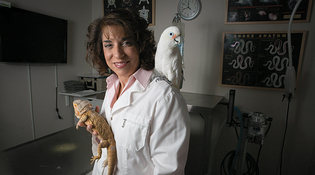 loading
loading
Where They Are Now“You never know what’s coming in the door.”Sugar gliders, monkeys, and potbellied pigs: veterinarian Laurie Hess ’88 has treated them all.  Julie BrownLaurie Hess ’88 sees a wide range of sick animals, from ferrets to potbellied pigs. Hess, shown here with a Goffin’s cockatoo (her own) and a bearded dragon, compares her work to that of a pediatrician; her patients “can’t talk and they bite when they are scared.” View full imageLaurie Hess ’88 is a seasoned veterinarian, but don’t expect her to spay your dog. Hess is owner and founder of the Veterinary Center for Birds and Exotics, in Westchester County, New York, where she treats “everything non-dog-and-cat that’s a domesticated pet.” As she relates in her recent memoir, Unlikely Companions: The Adventures of an Exotic Animal Doctor (written with Samantha Rose), Hess has ministered to patients the rest of us couldn’t even dream up—including a drooling hedgehog and a ferret that had swallowed several Barbie parts. Yale Alumni Magazine: What types of exotic animals do people keep as pets? Hess: The fads come in waves. There was a time when I saw a lot of sugar gliders [a type of marsupial]. We see potbellied pigs. Ferrets have always been around—but then they were made illegal in New York City. Reptiles are incredibly popular. Recently, rabbits have exploded. You never know what’s coming in the door. Y: What should people keep in mind when acquiring exotic animals? H: One of my biggest soapbox messages is that exotic animals can be great pets when cared for properly, but they’re not great for everyone. People like the different and the unique. But too many people don’t research animals and what their behavioral or nutritional needs are. Potbellied pigs start off at six or seven pounds, but unless they’re truly mini-pigs, they grow large. And even a mini-pig can grow up to 150 pounds. You get a cute little thing and end up with a 150-pound sow in your living room that you have to carry up and down the stairs. Y: Have you dealt with people keeping pets they shouldn’t have at all? H: There have only been a couple of times when I’ve called the animal police. In these situations, I urge people to not keep the animal and to give it up to an appropriate rescue facility—but in the meantime I need to make sure it’s treated properly. There was a very famous designer living in a high-rise apartment building with a small monkey that was inappropriate for her to have [because keeping a monkey as a pet requires a permit], and she’d had it for a long time. We did a house call and ended up neutering it. Y: Your memoir is structured like a detective story: you figure out what’s causing premature death among sugar gliders. Is being a vet like being a detective? H: It’s more like being a pediatrician. You have to rely on the owner, and half the time the owner doesn’t know what’s going on. For example, prey species don’t show illness—because, in the wild, they’d get killed. Also, just like little children, they can’t talk and they bite when they are scared. Y: Are there exotic animals you think are undersung? H: Degus. They look like oversized gerbils. They’re the size of a rat, but they’re brown and have hair on their tails. They’re intelligent and bond to their owners, and they’re sweet. Y: Americans spend more money on their pets than ever before. Why? H: There’s more to spend it on. I actually have another job: I’m the director of pet health and nutrition for a very large exotic–pet food manufacturer. So I go to a lot of pet trade shows, and it’s pretty amazing. There are things like pet feeders that recognize microchips—and only feed certain pets, to treat obesity. Y: Why do people have pets? H: People are lonely. We love the companionship and the nonjudgmental aspect.
The comment period has expired.
|
|